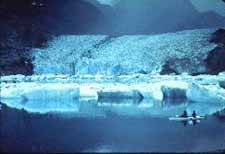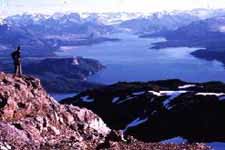 Park Details
Park Details
 Go to Park Details
Go to Park DetailsProclaimed Glacier Bay National Monument Feb. 25, 1925: established as a national park and preserve Dec. 2, 1980. Boundary changes: April 18, 1919: March 31, 1955,: December 1, 1978. Wilderness designated Dec. 2, 1980. Designated a Biosphere Reserve 1986. Designated a World Heritage Site in 1992.
Acreage
National Park:
3,225,284 (Federal: 3,224,938; Nonfederal: 346)
National
Preserve: 57,884 (Federal: 55,439; Nonfederal:
2,445)
Wilderness area:
2,770,000
 Park Details
Park Details
Location Information
Location:
Southeast Alaska, about 65 air miles northwest of Juneau.
Address:
P.O. Box 140
Gustavus, Alaska 99826
Telephone:
Headquarters: (907) 697-2230
Transportation:
Glacier Bay National Park and Preserve can be reached only by
boat or by plane. Travel options from mid-May through September
include scheduled and charter air services, a passenger ferry,
cruise ships, tour boats, and charter boats. Scheduled air
service is available year-round from Juneau to Gustavus. Bus or
taxi service from Gustavus to the park is available.
Operating Hours/Seasons
Open year round. Visitor center open only during the summer months.
Reservations/Permits/Fees
Fees
There are no entrance or user fees for non-commercial users.
Reservations/Permits
None required for non-commercial uses on the land. Private
motor vessels wishing to enter the park must have a permit
between June 1 and August 31. Reservations are recommended, as
these permits are limited, and may be obtained by contacting the
park. Campers are requested to obtain a permit, though these are
not limited. Reservations are recommended for most visitor
services offered by commercial vendors.
An Alaska state fishing license is required for fishing in the
park or preserve.
Climate, Recommended Clothing
Long periods of rainy, cool, and overcast weather are common in Southeast Alaska. Summer daytime temperatures range from 45- 65F. A hat, gloves, raingear and sturdy, waterproof footgear are recommended.
Facilities and Opportunities
Visitor Center/Exhibits
The park visitor center is located at Bartlett Cove, upstairs
in Glacier Bay Lodge. It has an information desk, book sales
area, and an auditorium. Exhibits illustrate natural and human
history.
Programs/Activities
Park naturalists present evening programs
and films daily in
the auditorium, lead hikes through the forest and along the
shore, and provide commentary on tour boats and cruise ships
entering Glacier Bay.
Lodging and Camping Facilities
At Bartlett Cove, Glacier Bay Lodge offers rooms, a
restaurant and bar, gift shop and fuel (gasoline, #2 diesel, and
white gas). The nearby town of Gustavus has several lodges and
bed and breakfast establishments. A primitive National Park
Service campground is available at Bartlett Cove, and there is no
fee.
Trails and Roads
The only road in the park runs from Bartlett Cove to
Gustavus. Seven miles of trails wind along the beaches and
through the rainforest in the area of Bartlett Cove.
Food/Supplies
Groceries, supplies and a small cafe are available in
Gustavus.
Accessibility
The visitor center at Glacier Bay Lodge is accessible to
wheelchairs, as is the first portion of the Forest Loop Trail
that is boardwalk. There are no paved roads or paths in the
area.
Other Concessions/NPS-Managed Visitor Facilities Glacier Bay Lodge operates day tour boat trips during the summer months. They also drop-off campers at designated locations. Various large cruise ship lines and smaller tour boat operators bring visitors into the park. Guided kayak trips and kayak rentals are available. There are guided kayak trips and backpacking trips, raft trips down the Alsek River, hunting and fishing guides, and lodging in the Preserve.
Recommended Activities/Park Use
Glacier Bay National Park and Preserve is most easily seen from a boat, as it is 60 miles from the developed areas of the park to view the tidewater glaciers. Activities include sightseeing, wildlife viewing, boating, kayaking, and ranger programs.
Visitation
Total visitation in 1995 was 254,160. Of that total, 203,789 came aboard cruise ships.
Basic Visit Recommendations
It is 65 miles from the forests of Bartlett Cove to the
tidewater glaciers. This boat trip is undertaken by almost all
visitors and is a highlight of Glacier Bay National Park and
Preserve. Because weather conditions can occasionally cause
flight cancellations, it is advisable to allow some extra travel
time in your itinerary.
Visitor Impacts
Black and brown/grizzly bears are wild animals and should
always be considered potentially dangerous. Help wildlife remain
wild by never feeding any animal, including squirrels and gulls.
Some areas are closed or restricted becasue of bear, nesting bird
colonies, feeding humpback whales, or other wildlife.
Additional Information
The majority of visitors view the park by cruise ships. Ship entries are limited to 139 through the summer to help protect endangered humpback whales which use the park waters. A smaller number of visitors see the park in smaller power boats or by kayak. When English explorer George Vancouver sailed through Southeast Alaska about 200 years ago, he charted only a small recess in the shoreline in the place where Glacier Bay is today. The "solid mountains of ice rising perpendicularly from the water's edge" that he described have retreated more than 60 miles and opened a vast bay to the sea. What was bare rock at the edge of the ice in Vancouver's time is now lush rain forest with huge Sitka spruce. Up bay, where the ice has departed in the past few decades, low plants are beginning to take hold. And at the end of the bay, tidewater glaciers still present solid mountains of ice.
Back to Park Details List
Top of Page
National Parks Home